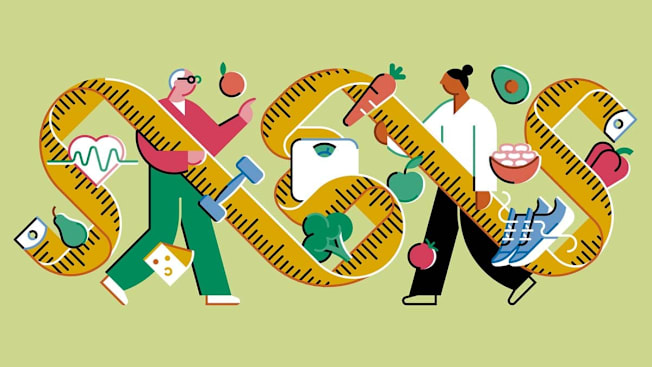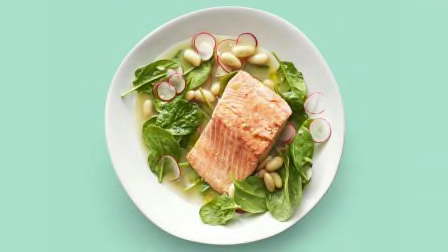Do You Really Need to Lose Weight?
Carrying a few additional pounds may be healthy as we get older

You may have heard of the obesity paradox—the concept that older adults who are overweight or even mildly obese may have better health outcomes than those who are at a “normal” weight. While there’s evidence to support the idea that current standards for overweight don’t apply to older adults, it doesn’t mean that weight doesn’t matter.
“Older adults with obesity will still be at greater risk for chronic health conditions, such as heart disease and type 2 diabetes,” says Kathryn Starr, PhD, an associate professor of medicine at the Center for the Study of Aging and Human Development at Duke University School of Medicine in Durham, N.C. But, she says, carrying a few extra pounds may give you something in reserve if you have an illness, a surgery, or a fall.
The Role of BMI
Typically, having a body mass index (BMI) between 18.5 and 24.9 is considered healthy. Someone is overweight when BMI is between 25 and 29.9, and obese when it’s 30 or higher. (You can find BMI calculators online.) But research suggests that as we age, those numbers may be too low.
Muscle Strength and More
While BMI tells you whether you might be carrying extra pounds, it doesn’t factor in how much muscle you have or where the fat is located, nor does it account for differences in age, gender, or race. That’s why the concern doctors have around weight in older adults is less about a specific number or metric and more about your physical condition and the ability to live your life independently, with minimal assistance. It’s always best to discuss your weight with your doctor, but these factors are important to consider.
Waist size: Fat in your midsection, called visceral fat, surrounds organs and may infiltrate muscle. That makes it more likely to contribute to a higher risk of heart disease, type 2 diabetes, and other health problems than fat that’s located elsewhere in the body. Waist sizes at or above 40 inches for men or 35 inches for women suggest you might need to lose weight.
Muscle mass and strength: A higher BMI might not be protective if you have more fat than muscle. Excess fat raises the risk of chronic health problems. Plus, with age your balance worsens, the risk of falls increases, performing activities of daily living is more difficult, and you may walk more slowly, says Lindsay Orbeta, RD, a sports dietitian at the University of California San Francisco who works with people pre- and post-surgery.
Muscle naturally declines with age, so you have to work to maintain and build it. “Adults lose 3 to 5 percent of muscle per decade [starting around age 30], and around age 70 we lose 6 to 10 percent per decade,” Orbeta says. “Even more important, strength declines by up to 3 percent per year.” Doing at least two strength training sessions a week that target all your major muscle groups is key to preserving muscle.
A DXA (dual X-ray absorptiometry) scan, which your doctor may have already recommended to test your bone density, can tell you how much fat and muscle you have (and estimate the amount of visceral fat). But some simple at-home fitness tests can also give you a sense of your muscle status, Starr says. Set a timer for 30 seconds and see how many times you can stand up from sitting in a chair. A 70-year-old woman should be able to do 10 or more repetitions; men, 12 or more. Or time how long you can hold a 90-degree squat while resting your back against a wall (shoot for 30 to 60 seconds).
Health status: Excess body fat can worsen certain conditions, such as heart disease, hypertension, type 2 diabetes, and osteoarthritis. If you have one of these conditions, weight loss may be in order.
Who Needs to Gain
According to current standards, a BMI below 18.5 is classified as underweight. But for older adults, a BMI under 22 is often considered too low, Starr says. “If you’re not eating enough calories, your body will break down fat and then muscle,” she says. “If you don’t have much fat, you’ll lose more muscle.”
You don’t want to cut back on activity as a way to conserve calories, so to gain weight, increase your food intake in an intentional manner. “Aim for nutrient-dense meals and snacks,” says Tracee Yablon Brenner, RDN, outpatient integrative dietitian project coordinator at Holy Name Medical Center in Teaneck, N.J.
Fat has twice as many calories as carbs or protein, so eating healthy fats—avocado, olive oil, nuts, and seeds—is a good way to bump up calories. Adequate protein will help you build muscle (via strength training). If your efforts to add pounds aren’t successful, check in with your doctor.
If You're Trying to Shed a Few
Should you need to lose weight, you want to do so in a way that maintains muscle and ensures you’re getting the nutrients you need. Follow these tips.
Slim down slowly. “No rapid or crash diets—otherwise, you risk losing muscle or having vitamin and mineral deficiencies,” Yablon Brenner says. “Aim for ½ to 1 pound a week.”
Don’t fixate on calories. “I’m not a fan of cutting calories so much as focusing on whole foods that you cook at home and trying to avoid empty calories,” Yablon Brenner says. She recommends making half your plate vegetables and fruits and trying to include 30 different types of plant foods per week to ensure you’re getting variety in your diet.
Prioritize protein. You need it to build and maintain muscle. Aim for 0.45 to 0.59 gram per pound of body weight daily, around 72 to 94 grams for a 160-pound person. Your body will be able to better absorb protein if you spread your intake out through the day in your meals and snacks.
Include exercise. Shoot for 150 minutes of moderate-intensity aerobic exercise—or 75 minutes of vigorous intensity—each week, in addition to two strength-training sessions. If you can’t meet that, do what you can.
Editor’s Note: This article also appeared in the December 2025 issue of Consumer Reports On Health.




















